What Hawks can you see in France? There are 3 different species of Hawks that you might encounter in France. Read this article to see pictures, hear their sound and get great information about where and when you can spot all Hawks in France.
From the sprawling lavender fields of Provence to the bustling heart of Paris, France is a country that seamlessly blends the rustic with the regal. Just as the nation celebrates its rich history, artistic triumphs, and culinary masterpieces, the skies above resonate with the tales of its avian wonders. Among these, the hawks hold a special place, soaring majestically and adding a wild, untamed note to the symphony of French landscapes. Let’s embark on a journey to meet these raptors of France.
Let’s jump into the article.
1. Eurasian Sparrowhawk (Accipiter nisus):
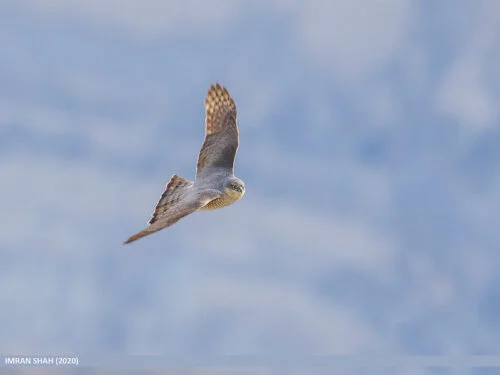
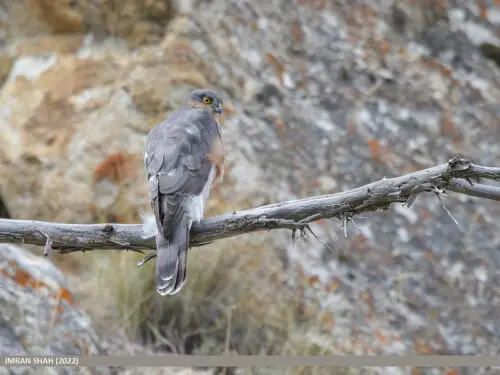
Adept and agile, the Eurasian Sparrowhawk is like the agile ballet dancer of France’s avian world. With a size not much larger than a thrush, this raptor has a slate-grey back and wings, while its underparts are finely barred, making it a beauty to behold against the azure French skies. The male boasts a distinct reddish hue, whereas the females don a more modest brown.
Sparrowhawks are masterful fliers, darting through woodlands with unparalleled agility, often surprising their prey—typically small birds. They’ve been known to weave through dense forests, displaying aerial acrobatics that would leave spectators in awe.
Nestled in the French countryside, from the rolling hills of Normandy to the lush forests of the Dordogne, the sparrowhawk’s sharp, kitten-like call often betrays its presence even before it’s sighted.
In French folklore, the sparrowhawk has long been a symbol of precision and finesse, much like a perfectly executed French recipe or a delicate piece of art from the Louvre. When touring the magnificent landscapes of France, keep your eyes peeled for this masterful predator, an embodiment of nature’s prowess and beauty.
2. Northern Goshawk (Accipiter gentilis)
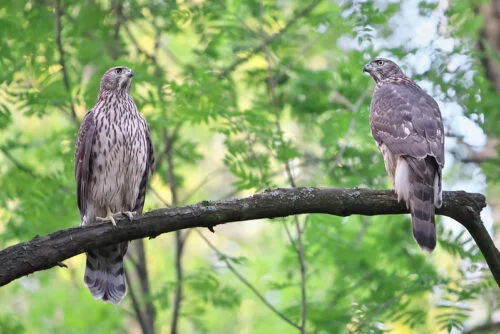
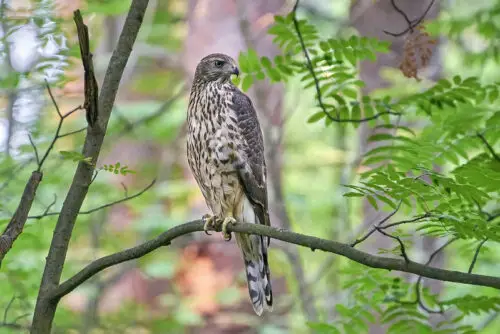
With an aura of mystery and a reputation for fierce efficiency, the Northern Goshawk is to the French skies what the Musketeers were to the courts of old—valiant, noble, and a force to be reckoned with. Bearing a regal stature amongst raptors, the Northern Goshawk is larger than the aforementioned sparrowhawk and is undeniably one of the most impressive predators in the French woodlands.
Cloaked in a mesmerizing palette of bluish-grey on its upperparts and finely barred underneath, the adult goshawk’s fiery red eyes are perhaps its most distinguishing feature—a penetrating gaze that seems to pierce through the very soul of the forest. The younger goshawks, in contrast, display a rich brown plumage and pale-yellow eyes, transitioning to their adult colors as they mature.
The French woodlands echo with the goshawk’s distinctive, sharp “ki-ki-ki-ki” call, especially during mating seasons. As a supreme hunter, it’s skilled in the art of pursuit, using its powerful wings and agile body to navigate through dense canopies, ambushing its prey with a surprise that’s both swift and fatal. While its diet primarily comprises birds and mammals, during leaner times, it’s known to hunt larger prey, showcasing its versatility and adaptability.
Steeped in folklore, the goshawk in France is often considered a symbol of strength and precision. Hunters and poets alike have been inspired by its fierce nature and unparalleled hunting skills. In medieval times, it was the bird of choice for many falconers, prized for its hunting prowess.
From the dense, green stretches of the Vosges to the expansive forests of Fontainebleau, the Northern Goshawk reigns supreme. As you wander through France’s majestic terrains, let the tales of the goshawk inspire you—a perfect blend of power, precision, and poetry, akin to a classic French ballad.
3. Rough-legged Hawk (Buteo lagopus)
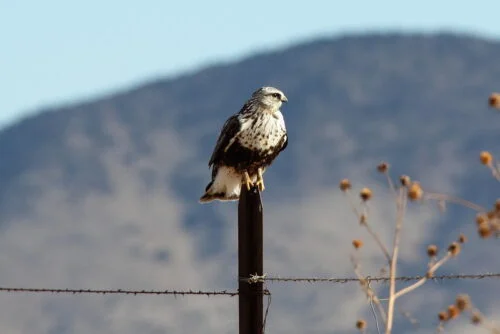
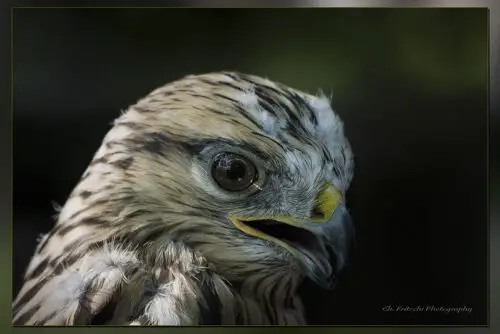
While the Eiffel Tower and the Louvre might steal much of the limelight when discussing France, bird enthusiasts often find themselves entranced by a less renowned, yet equally captivating marvel—the Rough-legged Hawk. A visitor mainly during the colder months, this raptor brings with it tales of tundras and the Arctic, a living testament to the magic of migration.
Sporting a size similar to the well-known Common Buzzard, what sets the Rough-legged Hawk apart is its feathered legs, extending all the way to the toes—a natural adaptation to its chilly homeland. Its plumage, a beautiful mosaic of dark patches against a lighter background, paints a picture of snowy landscapes interspersed with dark cliffs. Adult birds boast a distinct dark band trailing their tail feathers, giving keen birdwatchers a clear identifying feature.
While in France, these hawks favor open fields and wetlands, often hovering kestrel-like, scanning the ground below for unsuspecting rodents. Their diet mainly consists of small mammals, especially lemmings and voles, but they’ve also been known to dabble in a bird or two when the opportunity presents itself.
Their presence in France is often met with enthusiasm by birdwatchers, as the Rough-legged Hawk is not a year-round resident but a winter visitor, gracing the French skies with its distinctive flight pattern and ethereal beauty. Their journey from the Arctic tundras to the rolling French countryside is a testament to nature’s wonders and the incredible distances birds travel in search of sustenance and shelter.
In French folklore, transient birds like the Rough-legged Hawk often symbolize change, transition, and the cyclical nature of life. Their annual visit reminds the locals of the changing seasons, the circle of life, and the interconnectedness of nature.
As you sip on your Bordeaux or enjoy a croissant in a Parisian café, cast a glance at the skies above. You might just be lucky enough to spot the Rough-legged Hawk, a fleeting vision of Arctic wonders in the heart of France.

